The Rough-and-Tumble Sport of Roller Derby Is All About Community
Participants promote a family-oriented fellowship of friends who like to beat each other up while wearing skates
/https://tf-cmsv2-smithsonianmag-media.s3.amazonaws.com/filer/2b/34/2b345486-d4dd-473d-bb3c-417532cd8870/img_064_2.jpg)
The first thing you learn in roller derby is how to fall. The coach blows the whistle, and everyone falls down. Then you have to get back up on your skates—no matter how long it takes—without using your hands. Then you fall again. And again. Sometimes this drill continues for two minutes straight, as you fight against gravity, your own bodyweight, and the wheels under your feet. It’s exhausting.
Joining Baltimore’s Charm City Roller Derby, one quickly understands that there is real technique in falling. You can’t be embarrassed or shaken every time you hit the floor. In early practices, if someone falls spectacularly—even if it’s just from trying to stand still on skates—everyone claps. The people who stick it out and make the team are the ones who can laugh at themselves and recover quickly.
Roller derby is a rare example of a grassroots community rising from the ashes of a dead professional sport. It has grown into a movement, developing its own traditions and culture. Players skate under pun-laden nicknames, develop signature looks and champion inclusivity.
Today, derby is no longer played professionally. In fact, skaters pay to play with among other expenses, monthly dues, equipment, jerseys and insurance. Like most leagues, Charm City Roller Derby is volunteer-owned and operated. Skaters are expected to help run games and fundraisers, and must serve on at least one league committee.
A History of Derby
Leo Seltzer, a Chicago-based sports promoter, is credited with inventing roller derby in the 1930s. The idea came to him after he read an article asserting that more than 90 percent of Americans had roller-skated at least once in their lives. America, he determined, was primed to accept a sport like roller derby. Wacky contests had been all the rage in the 1920s, and playing sports from boxing to bike racing and dance marathons to flagpole sitting for prizes was common.
Seltzer’s derby began in the form of endurance races. These were multiday tournaments in which teams of two, often comprised of a man and a woman, took turns continuously skating laps around a banked wooden track for cash prizes. Spectators enjoyed the dramatic falls and pileups as skaters attempted to lap each other. In 1938, sportswriter Damon Runyon approached Seltzer with suggestion that he focus on the violence to bring in more crowds. It worked.
A point system was enacted. Pass an opponent, earn a point. Roughing them up along the way was encouraged. Frequently, players put each other in headlocks while skating at high speeds. Teammates would sometimes lock hands and spin, using one player to knock down opposing skaters. This rough play often led to fistfights and dramatic falls in heaps and piles. Referees dragged away skaters kicking and screaming. Audiences loved it.
Rivalries developed (or they were orchestrated by promoters), to the extent that they were sometimes billed as “good guys” or “bad guys.” Spectators delighted in rooting against a villain, and it heightened the stakes. It’s thought that many of the games were rigged. For a time, derby closely resembled professional wrestling, with all of its theatricality. Derby grew wildly popular, and fans packed Madison Square Garden. Soon it was televised, broadening the audience further. Even if you didn’t understand the rules, it was a thrill. Seltzer once summed up the sport’s basic appeal as being “noise, color, body contact.”
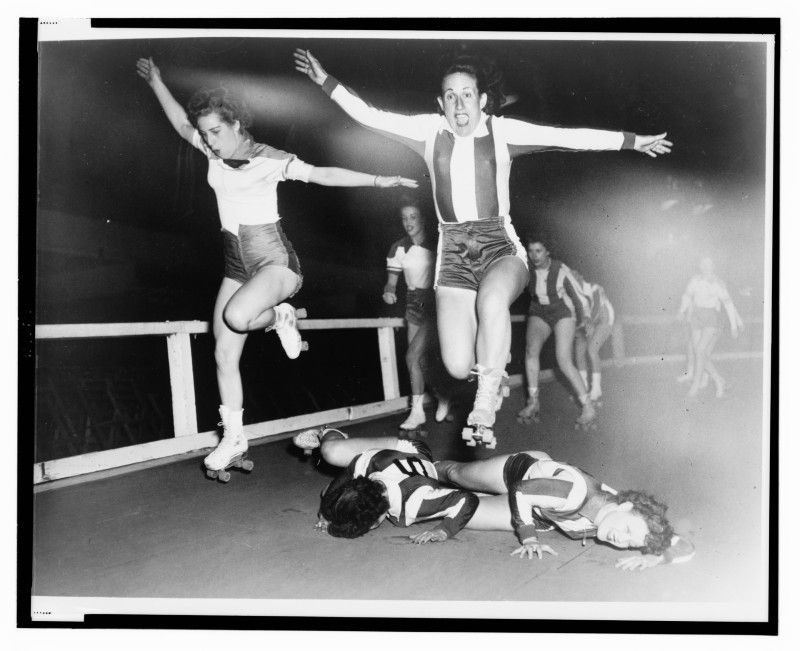
Derby has been an inclusive sport since its beginning. The leagues were always co-ed, welcoming openly gay players and all ethnicities. Each game was played by men and women in alternating periods, with their combined scores determining the winner. Although men and women only competed against their respective genders, they were always playing by the same rules. This was unique for the time, and still is today, as many women’s sports are modified versions of traditionally male ones.
However, early derby could not escape systematic sexism, as the yearly salaries of men eclipsed those of women by as much as $10,000 to 15,000. Despite this, derby women remained the highest paid female athletes for decades, often earning between $25,000 and $30,000 a year.
When people recall watching derby on TV, they almost always talk about the women’s teams. At that time, seeing women playing any sport at all—and a contact sport, no less—was memorable. The only other professional sports that routinely had female competitors were golf and tennis, a far cry from the thrills of roller derby.
By 1969, roller derby had evolved into a full-contact team sport. By the mid-1970s it was mostly over. Seltzer’s son Jerry shut down the league in 1973 due to rising oil prices, which had made touring and heating arenas too expensive. He owned all the teams, and when he disbanded them the game disappeared.
A few attempts were made to revive it. These included "RollerJam," a short-lived late-1990s TV show where teams played on inline skates, and 1980s skating competition called "The Roller Games," featuring events such as two masked skaters battling it out on a figure eight track surrounding two alligator pits. Yet, somehow, this didn’t catch on.
By the turn of the 21st century, most of what people remembered of derby was just women beating each other up on skates—until its resurgence in Austin, Texas in 2003. The "Texas Roller Derby," a campy DIY that was only open to women took on a feminist slant and prided itself on creating a space where women could be tough.
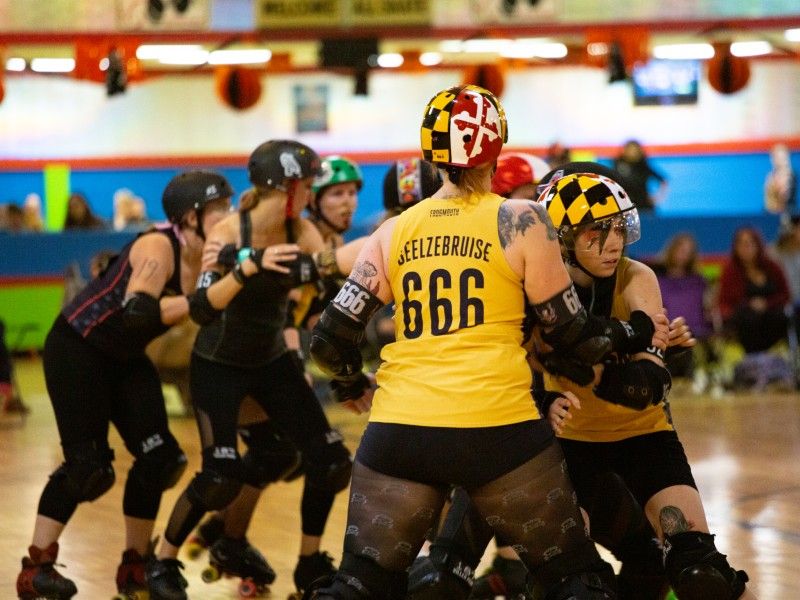
Rugby on Skates
The game has changed significantly since its inception and is now subject to stricter rules and regulations. Each skater is required to wear a helmet, kneepads, elbow pads, wrist guards and a mouth guard. Penalties are issued for rough play. Skaters are no longer allowed to punch each other in the face, on or off the track.
Most leagues play on flat tracks now, rather than banked, as they rent their practice spaces and aren’t able to modify them. Banked tracks require a lot of space and need to be custom built, but flat-track derby can be played almost anywhere: roller rinks, basketballs courts, empty warehouses, or thawed ice rinks. With a roll of tape, you can lay down a flat track in a fraction of the time it takes to set up a banked one.
Today’s teams consist of four blockers and one jammer. The jammer, wearing a starred helmet, scores one point for each opposing skater they pass. Blockers impede the opposing team’s jammer while assisting their own jammer through the pack.
There’s no punching or kicking, no throwing elbows, no contact with another player’s helmet or below the knee. But you would be surprised what you can achieve with your shoulders, hips, ribcages and thighs, which become powerful tools for pushing, hitting and resisting.
The change in gameplay was necessary in the move to flat track. It’s become slower, more contact-based rather than speed-based. What used to be a race is now a steady turn around the track that more closely resembles rugby on skates, with jammers fighting through the pack.
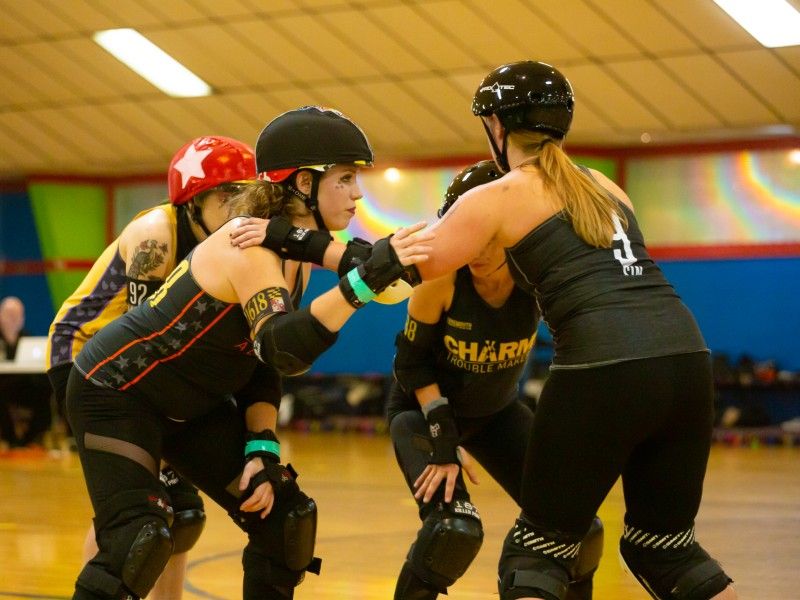
Glitter and Fishnets
Derby today is known for the punny nicknames skaters give themselves, a trend that appeared during the 2003 “flat-track revival.” Skaters at that time took inspiration from the Austin punk and drag scenes, creating alter egos and theatrical costuming. Well-known players include "Scald Eagle," "Freight Train" and "Lady Trample."
Since the revival, another prominent tradition has been the bout-day makeup. Some skaters develop a signature look, using everything from black lipstick and fake blood to rainbow eye shadow and copious amounts of glitter. Some aim to intimidate or emulate their name; others are just fantastical and fun. Most find some way to add flair to the uniform: neon spandex, metallic shorts, bandanas, fishnets, kilts. Embellishments are encouraged, even as derby has become more official.
The makeup is just one element that sets derby apart from other sports. It’s an “alternative” sport, one that isn’t taught in schools and that isn’t well known in most sports circles. It caters to the strange and the offbeat, and that’s reflected in its community and culture. It tries not to take itself too seriously. For most people, the shiny stuff is attractive: the physicality, the fashion, the idea of stepping outside themselves in creating a new persona. They end up staying for the love of the sport and the community that surrounds it.
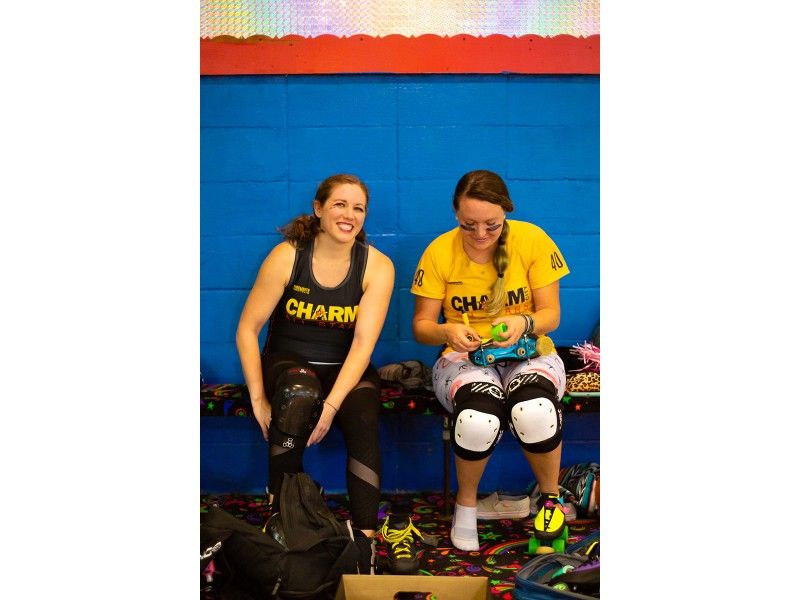
A Sport for Everybody and Every Body
Derby’s shift from a professional sport to a volunteer operated venture gives more of a feeling of community, fundamentally changing both the gameplay and the players. Keeping a league afloat requires vast resources and sheer willpower. The fact that derby exists at all today is a testament to the devoted people behind it.
There is clear evidence of community even during gameplay. At its core, derby requires communication; it’s a true team sport. The players are constantly yelling to each other on the track: shouting out coded plays, narrating what’s happening, where they’re moving next, asking for help. If they don’t stick together, the opposing jammer will get through their pack. Players need to know how each teammate plays, and they need to trust one another. A lone player is essentially useless on the track.
During the first few practices, coaches repeat the phrase, “Derby is for everybody.” Many prospective skaters assume they don’t have the “right” body type to play the game. I quickly found that such a thing doesn’t exist. I’m barely five feet tall and had never played a contact sport before, and (on a good day) I can push people twice my size. I’m low enough to the ground to drive my shoulder into their thighs and destabilize them.
I’ve seen just about every type of body succeed at this sport, each coming with its own advantages and disadvantages. A player with sufficient mass to block an opponent also has a higher center of gravity, making them more open to hits. Smaller players get knocked off their feet more often, but we’re also able to squeeze into tight spaces and slip past the opposing team.
Those unable or unwilling to put themselves on skates still have a place in our community. The league needs referees, officials, point-trackers, penalty-timers and all manner of volunteers to run bouts. The people who give their time to these tasks are integral to the league, and we strive to value them as the MVPs they are. Without them, there would be no game at all.
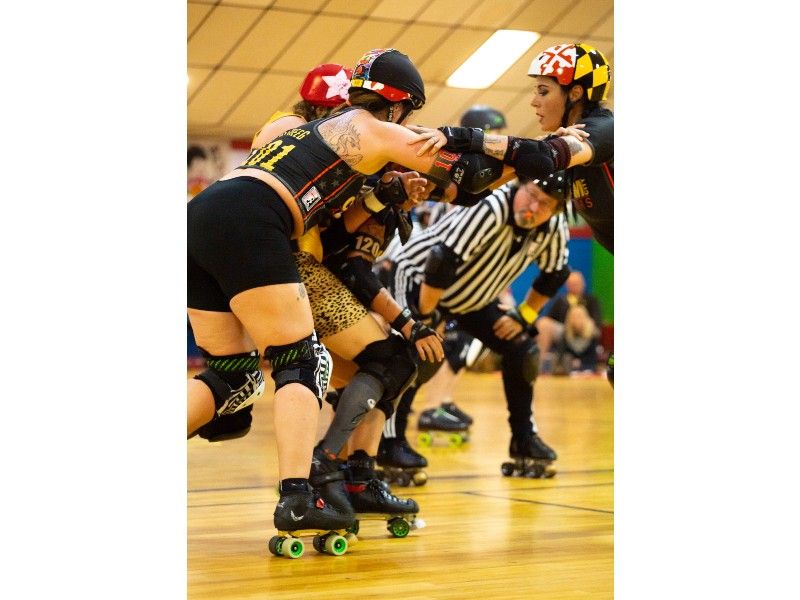
When I first joined, I assumed I would meet more 20-something women like myself. In reality, this sport attracts all sorts. I’ve met middle-aged single moms, married couples who skate together, college kids and nonbinary folks. Women twice my age have knocked me clean off my skates. I’ve watched former high school jocks skate alongside self-proclaimed nerds who have never played a sport before. Skaters who move into the area will transfer to our league, eager to find community in their new city.
Our league works to be inclusive and our players are diverse in many ways, but we have come to realize that Charm does not represent the racial demographics of our surrounding community. We are in the process of forming a diversity and inclusion committee to expand our recruiting process to reach everyone who may wish to join us.
This commitment to inclusivity is essential to derby and part of what makes it unique, allowing us to form new communities from all sorts of existing ones.
Our community is supportive, both on and off the track. We post to our league’s Facebook group, soliciting carpools, gear recommendations and pet sitters. We post there when we can’t make practice, adding that we’ll miss everyone. Coaches will message a teammate privately if they leave practice early without explanation, just to check in. Skaters sometimes invite the entire league to their house for the holidays to ensure everyone has a place to go. Members recovering from an injury or just having a tough time get signed cards from the league. This kind of support is what makes it easier to stick it out in such a demanding sport.
Most boot camp classes end up cutting themselves in half by the time tryouts roll around. People get injured, or are too busy, or disappear from practices without a word. And it’s easy to understand. This sport is time consuming, expensive and brutal both mentally and physically. I’ve thought of quitting more than once. But I never regret going to practice. I always leave it feeling better than when I walked in.
Today’s roller derby is an alternative, family-oriented community of friends who like to beat each other up while wearing skates. What started as a violent sport sprung from Depression-era thrills resurfaced decades later, forming a worldwide community founded on inclusivity and a “by the skaters, for the skaters” ethos. Literally and figuratively, we pick each other up when we fall down.
Gabrielle Puglisi is a Smithsonian intern and a graduate of Emerson College. She skates for Charm City Roller Derby under the name Pugnacious D. A version of this article was previously published in the online magazine of the Smithsonian Center For Folklife and Cultural Heritage

